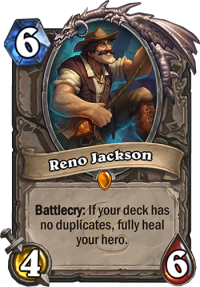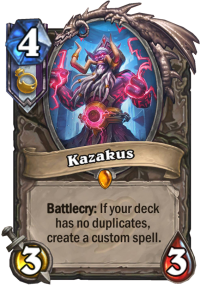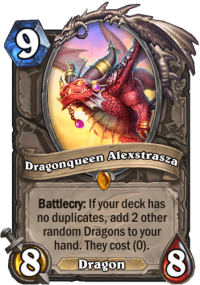Descent of Dragons is almost here! All the cards have been revealed – you can check out our full expansion guide and card list – and in this article, I will take a more in-depth look into the new rise of Highlander decks. With the December expansion, the Standard format card pool is at its largest, and this is naturally the best time to build decks where there can be only one copy of each card.
If you think Zephrys the Great is good, it is getting some serious company from Dragonqueen Alexstrasza, and as such, Highlander support will be at its highest level since the days when Reno Jackson, Kazakus, and Raza the Chained roamed the land unchecked and unrivaled.
Highlander Support Then and Now

The history of Highlander decks in Hearthstone starts from November 2015 and The League of Explorers adventure, which introduced the original Reno Jackson into the game. The concept of competitive singleton decks was a novel one, and Reno was experimented with in all classes. SuperJJ took an early win at SeatStory Cup IV with his Reno Jackson Freeze Mage, and we even had Belveder playing Reno Warrior in top-10 Legend. Reno Warlock became a widespread thing with Hoej as one of the archetype’s most recognizable connoisseurs. There were a couple of top tier Reno decks, and you could build a fun and somewhat viable tier two or tier three Reno deck for just about any class. Reno Jackson and Highlander decks were novel, reasonably powerful, and a lot of fun.
Too much fun can give you a tummy ache though. Blizzard looked upon its creation, and saw that it was good. Therefore, more Highlander support cards were designed, and in December 2016 Kazakus was unleashed upon the unsuspecting Hearthstone players. This increased the power of Reno decks for the classes where it could be played – Priest, Mage, and Warlock – but also meant that interest in other Reno decks waned, because the three chosen classes had such a bigger payoff from running single copies of cards.

The swing power of Kazakus slowly started the rise of Highlander fatigue, as people started to grow weary of seeing either Reno or Kazakus blow them out of the game, should one of those be drawn. The final nail to the coffin was the release of Shadowreaper Anduin in Knights of the Frozen Throne in August 2017, which provided Priest with a functional machine gun when combined with Raza the Chained. People grew desperate, and ultimately Raza the Chained was nerfed in February 2018. The Standard rotation of 2018 ended the reign of Reno decks, and a collective sigh of relief echoed across the planet.
Highlander decks had lived long enough to become villains. Would people have grown tired of them regardless, or was it the result of too powerful support for the archetype? Maybe it was because that support was limited to only a few classes, leaving the rest out in the cold? It is hard to come up with definitive answers, but as all Highlander support cards eventually rotated out of the Standard format, it looked like Highlander decks were gone for good, and that it was all for the better.
Blizzard, however, was not content. Deep within the hidden laboratories of Team 5, new Highlander support cards were being brewed. In a flash of flame and tears, Zephrys the Great was revealed to the world in Saviors of Uldum in August 2019 alongside its class brethren Elise the Enlightened (Druid), Sir Finley Mrrgglton (Paladin), and Dinotamer Brann (Hunter). Despite chosen classes getting more support than others, Highlander decks were built for all classes with a moderate level of success (and, ironically, Druid used Elise and Zephrys in decks that were not Highlander decks, just because they could).
Some level of balance was achieved between Highlander decks and regular decks, until Evolve was resurrected and destroyed everything. Luckily, Evolve went away again relatively quickly. Whew.

Highlander decks are at their strongest when the card pool is large, and therefore the December expansion is always their peak, right before a new Standard rotation in April takes away many of their options. It was therefore already expected that Highlander decks would grow stronger with the new expansion, but Blizzard wanted more. Too deep they dug, and too greedily, and they wakened Dragonqueen Alexstrasza, Duplicate’s Bane, who is about to join the ranks of Highlander decks in the new expansion. With a flurry of new dragons coming, the new Alex opens up opportunities to build Dragon Highlander decks, but it can also be used without other Dragons in any regular Highlander deck.
Therefore, the future looks bright for Highlander decks. I have theorycrafted Highlander decks for all classes, and while there are a couple of classes that can be a little clumsy to play as Highlanders (especially Druid), it looks like Highlanders can be very strong in Descent of Dragons. Let’s take a look at the new decks!
Druid
Druid turned out to be the most difficult Highlander deck to build. With a Highlander deck, you cannot effectively use Untapped Potential, and Quest Druid has been insanely powerful, effectively turning every Druid win condition into a variant of itself. The Quest is at the core of the modern Druid experience, no matter whether you play a Malygos deck or a Nomi deck.
So, while I did build a Highlander Druid deck, I came to the conclusion that it sucked. I’d much rather put Elise the Enlightened, Zephrys the Great, and Dragonqueen Alexstrasza into a Quest Druid shell and simply use them once I get through most of my deck. Druids do not play by the rules, they’re cool like that.
There is even some anti-synergy in this list, as Ysera, Unleashed shuffles duplicates into the deck. This anti-synergy, however, is more apparent than real, because you go through those extra dragons quickly and they provide additional tempo on the way to the ultimate end game.
Hunter
There are at least two approaches you can take to Highlander Hunter in Descent of Dragons: you can go deep into Dragons or you can keep the Secret package and just splash in Dragonqueen Alexstrasza. I have built sample theorycrafting lists of both approaches.
The Highlander Dragon Hunter foregoes the defensive power of the Secret package in favor of fully utilizing the power of Dragons. This gives the deck additional Rush capabilities with Evasive Wyrm, additional resource generation with Primordial Explorer, Brightwing, and Firetree Witchdoctor, and a serious threat with Stormhammer. Who needs Eaglehorn Bow anyway, when you can have a hammer that just does not lose durability.
The Highlander Secret Hunter stays close to the ideals of Highlander Hunter from Saviors of Uldum. Secrets help it navigate the early game and come back as a fully formed Christmas tree with Zul'jin later in the game. Meanwhile, an assortment of powerful Hunter cards keeps up the pressure, and Dragonqueen Alexstrasza is splashed on top as a lone Dragon, because her power is too great for any Highlander deck to ignore.
Mage
I went through multiple iterations of Highlander Dragon Mage. Initially, I built it as a semi-combo deck that reduces the health of the opponent to 15 with Alexstrasza and finishes the job with Dragoncaster, Pyroblast, and Fireball for 16 damage for ten mana.
However, after I saw how good Pirate Warrior looked like in the early access streams, I streamlined the deck and made it faster, and that included cutting all ten-mana spells from the list. The reveal of Cobalt Spellkin opened up a new avenue to find burn spells with Archmage Antonidas, and the deck ended up becoming a more straightforward Dragon deck that can generate pressure with its various minions and ultimately Dragonqueen Alexstrasza, and finish the job with Fireballs generated by Archmage Antonidas.
Paladin
- 2Faerie Dragon1

- 2Firetree Witchdoctor1

- 2Zephrys the Great1

- 3SN1P-SN4P1

- 3Scalerider1

- 4Dragonmaw Poacher1

- 4Evasive Feywing1

- 4Frizz Kindleroost1

- 4Twilight Drake1

- 5Cobalt Spellkin1

- 5Dragonmaw Scorcher1

- 5Harrison Jones1

- 5Zilliax1

- 6Evasive Wyrm1

- 7Countess Ashmore1

- 7Crowd Roaster1

- 7Evasive Drakonid1

- 7Siamat1

- 9Dragonqueen Alexstrasza1

Any Dragon Paladin deck just has to be a handbuff deck, right? With access to both Dragon Speaker and Glowstone Technician, even a Highlander Dragon Paladin can find some handbuffs fairly reliably. Dragonrider Talritha may not have particularly impressive stats for a three-drop, but the Paladin three-drops suck anyway, so it is not that bad of a card to play in that mana slot for the class. It requires a lot of Dragons to be good, but Paladin has access to more Dragons than any other class and can easily fill even a Highlander deck with them.
I have also opted to use Nozari in the deck: you don’t particularly mind that the opponent heals to full health when you are playing minions with 7/15 or 10/7 stats non-stop. If you can survive to turn ten against aggro decks, Nozari might be just the right tool to stabilize and deprive your opponent of all hope.
Priest
I have to admit that I am not sure what Priest is supposed to do in Descent of Dragons. My best guess is that you just play Combo Priest as if nothing happened. Alternatively, you can use the new zero-cost spells to make Nomi Priest even faster than before. Neither of those archetypes really work as a Highlander deck though, so I had to try to come up with something else for this piece.
Therefore, I proudly present the Highlander Galakrond Dragon Priest, a deck that kills minions, even if it does not kill players. Eventually, the endless stream of random Priest minions may kill players too, especially if Princess Talanji succeeds in summoning a large number of them at once. Add in Murozond the Infinite and Dragonqueen Alexstrasza, and Priest actually has multiple potential tempo swings for the late game.
Rogue
While Tempo Rogue has been the best-performing Rogue deck in Saviors of Uldum, Highlander Rogue has also seen a fair bit of play. It is basically a less consistent Tempo Rogue that has a few additional tricks up its sleeve. This Descent of Dragons Highlander Rogue theorycraft has been built based on these same principles: it is a Tempo Rogue at heart, but one that wants to kill the opponent in a hundred different ways instead of murdering them with brutal but boring efficiency.
Because all Rogue Invoke cards generate Lackeys, it is easy to include Heistbaron Togwaggle in the deck. The Lackeys can also be excellent fodder for Faceless Corruptor.
Shaman
- 2Acidic Swamp Ooze1

- 2Faerie Dragon1

- 2Firetree Witchdoctor1

- 2Hench-Clan Hogsteed1

- 2Zephrys the Great1

- 3Brightwing1

- 3SN1P-SN4P1

- 3Scalerider1

- 4Devoted Maniac1

- 4Dragonmaw Poacher1

- 4Evasive Feywing1

- 4Sandbinder1

- 4Scaleworm1

- 4Twilight Drake1

- 5Cobalt Spellkin1

- 5Dragonmaw Scorcher1

- 5Faceless Corruptor1

- 5Shield of Galakrond1

- 5Zilliax1

- 6Kronx Dragonhoof1

- 7Countess Ashmore1

- 7Siamat1

- 9Dragonqueen Alexstrasza1

Shaman has several options on where to take its Highlander deck. Corrupt Elementalist‘s double Invoke makes it easier for Shaman to Invoke Galakrond, so a Highlander Galakrond deck is closer to Shaman’s reach than it is for most other classes. Shaman also has good synergy with Dragons, because most Dragons have a Battlecry, and Shudderwock can be used to repeat them later. In this hybrid build, I have opted to use both Galakrond and Dragons to create a steady stream of threats throughout the game.
Warlock
Highlander Warlock decks can be built as fast and slow variants: the best Highlander Warlock in Saviors of Uldum has been a Zoo deck, but various control decks have also been attempted. With the new Handlock tools in Descent of Dragons, Control Warlock can be attempted yet again, even though Hearthstone is a tempo-oriented game where Zoo has a more natural path to success.
This Highlander Dragon Warlock deck is as close to a control deck as I have dared to build it. With Dark Skies, Nether Breath, and Crazed Netherwing adding more removal tools to Warlock’s arsenal, Abyssal Summoner providing a good mid-game Taunt minion, and Zzeraku the Warped and Dragonqueen Alexstrasza adding new win conditions, the deck has a chance to succeed.
The bigger question is whether any control deck can weather the storm unleashed upon the field by all the powerful new bombs introduced in Descent of Dragons. However, should it fail, there’s always Zoo.
- 1Beaming Sidekick1

- 1Blazing Battlemage1

- 1Crystallizer1

- 1Mecharoo1

- 1Murmy1

- 2Crazed Alchemist1

- 2Dire Wolf Alpha1

- 2Knife Juggler1

- 2Zephrys the Great1

- 3History Buff1

- 3SN1P-SN4P1

- 4Defender of Argus1

- 4Devoted Maniac1

- 4Dragonmaw Poacher1

- 5Faceless Corruptor1

- 5Leeroy Jenkins1

- 5Shield of Galakrond1

- 5Zilliax1

- 6Kronx Dragonhoof1

- 9Dragonqueen Alexstrasza1

Galakrond, the Wretched‘s Hero Power summons two 1/1 Imps, and that basically means that you’re an Odd Paladin now. Highlander Zoo Warlock was successful in Saviors of Uldum, so perhaps it can also succeed in Descent of Dragons. You have an endless supply of 1/1 tokens, so there are plenty of targets for the likes of EVIL Genius, Dire Wolf Alpha, Knife Juggler, and Faceless Corruptor. The Highlander part of the deck adds Zephrys the Great and Dragonqueen Alexstrasza to the mix, providing flexibility in the form of board clears or even a Bloodlust as well as a powerful refill later in the game.
Warrior
- 0Inner Rage1

- 1Eternium Rover1

- 1Improve Morale1

- 1Sky Raider1

- 1Town Crier1

- 2Cruel Taskmaster1

- 2Frightened Flunky1

- 2Rampage1

- 2Warpath1

- 3Bloodsworn Mercenary1

- 3EVIL Quartermaster1

- 3Frothing Berserker1

- 3Livewire Lance1

- 4Kor’kron Elite1

- 4Restless Mummy1

- 5Arcanite Reaper1

- 5Darius Crowley1

- 8Grommash Hellscream1

This Highlander Warrior deck builds upon the success of Saviors of Uldum Highlander Warrior: an aggressive midrange deck that has some scary burst damage in the form of Leeroy Jenkins + Inner Rage + Bloodsworn Mercenary.
The new additions include Dragonqueen Alexstrasza as a new late-game bomb, Sky Raider as a new one-drop that generates additional resources when played, and Hoard Pillager as a tempo minion that allows you to re-equip one of the weapon you have used in the game.
- 1Eternium Rover1

- 1Execute1

- 1Shield Slam1

- 1Town Crier1

- 1Whirlwind1

- 2Dragon Roar1

- 2Shield Block1

- 2Warpath1

- 2Weapons Project1

- 3Smolderthorn Lancer1

- 4Molten Breath1

- 4Omega Devastator1

- 4Restless Mummy1

- 4War Master Voone1

- 5Brawl1

- 5Emberscale Drake1

- 5Plague of Wrath1

- 5Supercollider1

- 7Dr. Boom, Mad Genius1

- 8Deathwing, Mad Aspect1

Any discussion of Warrior just has to include Control Warrior. With Dragonqueen Alexstrasza and its potential synergy with War Master Voone, a Highlander Control Warrior is likely going to go for Dragons as their minions of choice.
OK, I’m not ready to give up on Dr. Boom, Mad Genius quite yet, so the deck includes the famous Hero card and a small contingent of Mechs: Eternium Rover, SN1P-SN4P, Omega Devastator, and Zilliax. However, the main focus has moved towards Dragons. I just can’t wait to see Deathwing, Mad Aspect in action!
Highlander Life Is the Good Life
Things look promising for Highlander decks in Descent of Dragons. Almost all classes can have a viable variant of the archetype, and some are probably able to build multiple viable Highlander decks. Whether the new power brought by Dragonqueen Alexstrasza will be a good thing or a bad thing remains to be seen: Highlander decks were already good and now they are given even more tools, but on the other hand the whole expansion looks incredibly powerful, so perhaps this boost will not take them over the top. Hopefully so, because Highlander decks, while a lot of fun, are also the most expensive decks in the game to build, so if they are too powerful, it will simply lock budget players out of the game. There is still hope that Blizzard managed to hit just the right balance this time.












































































































































For the Gal Warlock: Dragonqueen just seems so slow at 9 mana. I think I’d rather see either a Jumbo Imp and/or Sea Giant which I can hopefully cheat out early thanks to invokations.
Great article! I can’t wait to try out these decks.
I read the prologue with Morgan Freeman’s voice in mind and thus have literally travelled the hearthstone timeline with Reno smiling all the way
Awesome read OG
Great article as usual Old Guardian, thank you. This hyped me up for the new expansion when my interest in standard had come to a grinding halt thanks to the current meta and battlegrounds.
So I noticed Brightwing in some lists. I really wonder if this is going to be a ‘need-to-craft’ card just due tu the fact that it’s a playable neutral dragon.
Same thoughts here, but just let the expansion drop and look how the meta is evaluated.
I wouldn’t start crafting cards right at release day.
No, if you are desperate enough to put Brightwing for the lack of better dragons, the deck is not good
I have played with Brightwing a fair bit, and really like the card, especially in value-based Highlander decks. That said, you can replace it with one of the other dragons we’re getting.